Travel Information - extensively
revised in October 2009
Click to view the weather
forecast for Tovste.
Introduction
This chapter describes how to get to and from Tovste
and Chernivtsi (the nearest 'large' city, 75 km or 90 minutes
driving time to the south) by various means of transport –
including airplane, train, coach / minibus, private taxi,
and rental car; as well as information on various accommodation
options in town or within driving distance; and practical
advice to take the guess-work out of routine daily activities.
The advice is based on over ten years of experience.
Although some of the information is specific to travel in
this area, much of it is relevant or can be applied to other
destinations in western Ukraine. You may also find additional
useful information on various Ukrainian message boards and
chat forums mentioned in the Useful
Links section.
Many people travel to Ukraine as part of pre-arranged package
tours. Typically they are met at the airport by a driver who
takes them to their destination, and stays with them throughout
their visit. I have no experience with this kind of travel,
but it obviously offers advantages in terms of comfort and
convenience if one is willing to pay extra for this kind of
personalised service. Tour companies may take you to interesting
places that you would not otherwise know about or be inclined
to visit.
Alternatively, if your budget is limited, with a little advance
knowledge and a spirit of adventure you can do things on the
cheap and still get a flavour of the real Ukraine, whilst
interacting with the local people and their customs.
Air travel
Entering Ukraine via Lviv 
Travelers from abroad have a number of options for getting to
Ukraine by air, then taking other forms of transport to reach
Tovste or other cities with reasonable hotel accommodation in
the vicinity. One option is to enter through Lviv (also
known as Lvov or Lemberg, in former times), which is well
served by direct daily flights of several airlines affiliated
with the ‘Star Alliance’: for example, from Vienna
on Austrian Airlines, from Munich on German Lufthansa Cityline,
from Warsaw on LOT Polish Airlines, and from Istanbul on Turkish
Airlines. Lviv is also served by Ukraine International Airlines
from various European destinations; and from Kyiv by an AeroSvit
affiliate (see below).
Important note: it has been reported that
Lviv Airport will close for renovations from 1 April 2010,
in preparation for the European Football Championship in mid-2012.
Although it is still not a certainty that Lviv will actually
host some of the matches, upgrading of the terminal building
and runway are long overdue. How long this temporary closure
will last isn't known, but it has been suggested that during
the renovations airlines might elect to shuttle passengers
to Lviv by ground transportation from Ivano-Frankivsk, which
hosts the next closest airport.
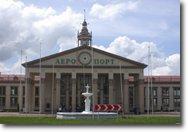 |
Lviv's small airport, with its characteristic
Stalinist-era architecture, is located on the outskirts
of town. After reaching the terminal building by shuttle
bus (upgraded in recent years), there is usually a scrum
in the small arrival hall to obtain immigration forms
and customs papers. I have never seen these made available
on any flight before landing, so try to remember to pick
up extra copies to save some time on your next visit.
|
|
There are normally two immigration officers on duty; they
are generally hospitable and the queue is usually processed
quite efficiently. In any case, it always takes some time
for the baggage to be manually transported a few hundred meters
from the aircraft to the luggage room next door, so it’s
not worth fussing about the time it takes to get through immigration.
After collecting your bags, you will be asked to put them
through an x-ray scanner, normally only a formality. At least
in former times (but perhaps no longer), there is one final
check before exiting the baggage hall, where you will be asked
whether or not you have medical insurance. I have never answered
anything other than “Yes” to this question, which
assures that you will be sent quickly on your way into the
airport lobby to face a thick crowd of people waiting to greet
the arriving passengers. On the other hand, if you really
do require travel insurance, before your journey you might
want to consult www.tryukraine.com
which gives details of reasonably priced health insurance
(and lots of other practical information and advice on Ukraine).
If you are also departing from Lviv: note that the check-in
facilities for at least a couple of airlines (eg. Lufthansa,
Austrian) have been moved from the main building to an annex
about 20 m off to the right, as you face the airport. I imagine
this somewhat ad hoc arrangement will be discontinued in the
course of the renovation of the terminal building, described
above.
* * * * *
There are a couple of options if you are heading into Lviv
in order to catch a connecting train or, better yet, to stay
overnight to see the sights of this charming city:
(1) Normally, there is a cluster of unlicensed 'taxi drivers'
around the entrance who will approach you with an offer to
take you in their private car for the journey into town –
about 15-20 minutes depending on traffic. The vehicles might
not be in the best of condition, but I have never had any
difficulties with these drivers. The first price they quote
will likely be inflated, but this can be negotiated downward
if one is firm about it. It’s not worth haggling too
much though, as the fare is normally only about 40 Hryvnia
(roughly USD 5). Just make sure the rate is agreed and understood
by both parties before setting out. Hotels in the city centre
typically charge upwards of 2-3 times this amount for airport
pick-up.
Meter taxis do exist in town, but you would be lucky to find
one operating out of the airport. I find these meter taxis
to be the least hassle of all and the most economical (in
the order of 20-25 Hryvnia) for the return journey to the
airport. An extra charge for luggage in the boot offers the
only opportunity for extracting a few more Hryvnia from your
wallet.
(2) For the more adventurous, thrifty types there is also
a trolley bus into town which departs from a stop located
about 40m off to the left as you exit the airport building
– more or less in front of a store selling bathroom
fixtures and tiles. The trolley bus costs only about 2-3 Hryvnia
and is okay if you are not burdened by heavy luggage. Otherwise
it can get rather crowded and uncomfortable since it collects
passengers as it approaches town. It ends up in the centre
of Lviv, but unless you have a map showing where your hotel
is, it is perhaps not so convenient to use this cheap mode
of transport when you first arrive.
Train travel is described in more detail below, as is the
option of hiring a rental car at the airport. Depending on
your arrival time in Lviv and the amount of time needed to
get through the arrival formalities, it is technically feasible
to catch connecting trains that depart from Lviv's main station
for Tovste or Chernivtsi, an hour or so after landing. In
the past, I managed a few times to make a 1500 train after
arriving at 1400 on the LOT flight from Warsaw! Nowaways,
all of the Star Alliance flights, except for Austrian Airlines,
arrive in Lviv between 1215 and 1420; and the trains now depart
somewhat later (eg. 1533, 1645), so catching one of them is
definitely possible. However, this strategy is predicated
on knowing how to buy a train ticket, where to find the platform,
and which wagon to get on etc., and is, therefore, probably
not realistic for first-time visitors.
In any case, this advice is not meant to dissuade you from
staying in Lviv, which certainly warrants a visit of at least
2 or 3 days. Should overnight accommodation be necessary,
I can recommend the Swiss
Hotel, which is centrally located on Knyazya Romana Str.,
with room rates that start at about 750 Hryvnias per night,
including breakfast (October 2009 prices).
Entering Ukraine via Kyiv 
A second option is to fly into the Ukrainian capital of Kyiv
(or Kiev), which is well served by many international airlines
and Ukrainian carriers, such as AeroSvit
or Ukraine International Airlines. From there, one can connect
to Chernivtsi with a domestic flight or train. I have taken
the train a few times, and I would recommend it highly, if
only once, because it allows you to soak up the scenery at
a leisurely pace – that is to say, an overnight journey
of some 15 hours or so. In former times, the train used to
pass through the neighbouring country of Moldova; with an
immigation/customs check en route that helped to break up
the monotony of the journey.
If time is an important consideration, air travel is a very
convenient alternative. Over the past five years, there has
been a steady evolution in the quality and frequency of service
between Kyiv and Chernivtsi. The route is nominally served
by AeroSvit, using aircraft operated by smaller affiliates,
such as Dniproavia.
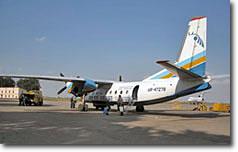 |
|
The domestic airline operating the Kyiv
- Chernivtsi route in 2005 had the catchy name of: "Kyiv
Aircraft Repair Plant (ARP) 410". The company typically
deployed a 1960's vintage Antonov-24. This propeller-driven
aircraft, shown here, is similar to the ATR-42 used
in the West. Apart from their age and condition, I found
them to be remarkably comfortable and spacious inside,
albeit rather noisy. |
Over the last couple of years, more modern aircraft –
such as the Saab 340 or Brazilian Embraer 145, pictured below
– have been introduced on the KBP-CWC route. The flight
time remains about one hour and 15 minutes.
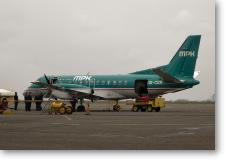 |
|
|
|
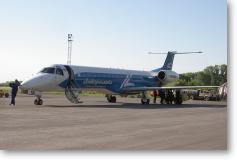 |
Incidentally, if one has the inclination, a bit of "web
sleuthing" can reveal the pedigree of the individual
airplanes in the fleet of AeroSvit and its affliates.
Two of the three AeroSvit 767 "workhorses"
used on international routes are about 20 years old,
having been acquired from SAS in the early 2000's. The
Embraer 145's in the fleet operated by Dniproavia have
an average age of about 10 years.
* * * * *
As convenient as it may be to fly into Kyiv and connect
to a flight bringing you directly to Chernivtsi, all
is not well as I write this in October 2009. Despite
the popularity of the KBP-CWC route – reflected
in apparently high passenger volumes – all flights
operating under the AeroSvit name have been cancelled
for the second time this year, both times without any
explanation whatsoever on the AeroSvit website. Other
western Ukraine destinations have been similarly affected.
While the disruption in early 2009 may have been a consequence
of the economic downturn, the abrupt halt in October
2009 may be linked to an ongoing labour dispute with
AeroSvit pilots, which was reported in the media. An
inquiry to AeroSvit was met with the ever so informative
Soviet-era response that "the flights were cancelled
due to technical reasons".
But it's not even clear whether this is the real picture.
Dniproavia, which operates the flights that used be
bookable online through the AeroSvit website, has its
own website showing the following timetable for Kyiv
- Chernivtsi: 1425 - 1535 Mon-Fri and 1730-1835 Sat-Sun;
and Chernivtsi - Kyiv: 1650-1800 Mon-Fri and 1530-1635
Sat-Sun. Perhaps these flights are still operating after
all; and their unexplained removal from the AeroSvit
website simply reflects the end of a marketing agreement
between AeroSvit and Dniproavia?
|
A few words about Kyiv's Boryspil
Airport. It used to be that if you were connecting to
Chernivtsi from an international flight, you would have to
pick up your luggage and take it yourself to the domestic
terminal. This burden was lightened as of mid-2007. You can
now have your bags retagged inside the international luggage
claim room, and they will be redirected to the connecting
domestic flight. The domestic terminal is walking distance,
but you must exit the international terminal and walk outdoors
– to the right, past all of the taxi touts – for
a couple of hundred meters.
Note (from 2007, but probably still valid):
When transferring or checking in for the connecting flight,
you will likely be told that you have excess baggage. AeroSvit
is very assiduous about maximizing its revenue from this source,
which amounts to about USD 8 per kg on international flights
and USD 1 per kg on domestic routes. (In other words, if you
are 12 kg over the 20 kg limit, this can add more than a couple
of hundred dollars to the cost of your return ticket on AeroSvit.)
It used to be that the agents in Kyiv would give you a bit
of break on the number of kilos if you paid on the spot and
did not request an official receipt, but these days everything
seems to go by the books. You will be directed to another
office in order to pay and secure a receipt, which you then
surrender in exchange for your boarding pass.
With the increasingly popularity of travel to Ukraine in
recent years, the capacity of the country's main gateway has
become stretched. Expect long queues at immigration on arrival
unless you happen to arrive at a quiet time of day. More importantly,
upon departure for international flights be prepared for delays
and a bit of chaos at the security / immigration checkpoints,
as many hundreds of travelers are funneled through just a
few stations. Hopefully a new terminal presently under construction
will help to ease the congestion.
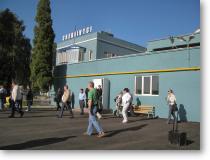 |
|
The reception on arrival at Chernivtsi
airport is decidedly low key. There is no need even
to go inside the turquoise terminal building, pictured
here.
Luggage is offloaded onto a trolley which is rolled
over to a fence where people are left to themselves
to collect their bags before exiting through a gate.
|
On the other side, a number of taxi touts will be waiting
to charge exorbitant prices for the journey into town or to
the Cheremosh Hotel, which is conveniently located only about
3-4 km away. There might also be a public bus, but the stop
appears to be several hundred meters up the lane.
When it operated, for many years the daily flight from Chernivtsi
to Kyiv departed at around 0800-0830 in the morning. Don't
be too anxious to arrive early for the flight, as you are
likely to find the terminal building locked until 0700-0715.
Unless you are with a driver who is familiar with Chernivtsi,
finding the airport at all might be a bit of challenge though,
since there are absolutely no signs on the roads leading to
it to indicate where it is! (The airport is situated more
or less south-east of the city centre.)
Trains — from Lviv / Kyiv to Tovste and Chernivtsi 
Train travel in western Ukraine is extremely inexpensive
and, from my experience over the past decade, very punctual
and reliable. You usually travel in an open or closed compartment
that has four berths (i.e. fold-down beds), which are comfortable
for sleeping or just relaxing. I highly recommend travelling
by train, but with a few caveats, described below.
There are several trains each day from Lviv to Tovste, with
journey times ranging from 6½ to 7 hours or more, depending
on the service. Securing a ticket in the train station in
Lviv can be a bit of an adventure, made easier if you have
done a bit of research in advance. TIP: I
have found that the train schedules for western Ukraine on
the Deutsche
Bahn website (yes, German railway system!) are generally
reliable and very informative. Select the English language
option, and type in Lvov and Tluste or
Chernovcy (note the spellings) in the departure/destination
boxes. Armed with the precise train times and numbers makes
it much easier to deal with the ticket vendors in the Lviv
station, who generally cannot converse in English.
The train station in Lviv is a bit dreary and crowded, but
one can buy food there, eat in the restaurant, and use the
washroom facilities etc. The queues for tickets tend to be
long and you will undoubtedly experience a sense of frustration
when the ticket agents close up shop for about 10 minutes
every hour while they take their scheduled break. TIP:
It is advisable to travel with food and drink, as there is
little to offer on the train itself, except hot tea. When
booking the train ticket you will be assigned a particular
wagon, compartment and berth. The cost of a ticket from Lviv
to Chernivtsi was constant for years, at about 25 Hryvnia
(less 5 USD), but it may have increased somewhat in recent
years.
It is advisable to go to the platform about 20 minutes before
the scheduled departure, since the train usually arrives about
10-15 minutes in advance, and there is always a scramble to
get on board with awkward luggage. As soon as the train pulls
in, try to approach one of the conductors on the platform
who will direct you to the correct wagon, if you haven’t
already figured it out from the ticket. The compartment and
berth number is also written on ticket, but can this can be
a bit difficult to decipher, so ask for help before or after
boarding.
The journey itself should offer no surprises. It’s
a great chance to catch up on sleep, paperwork or just enjoy
the scenery slip by during the daytime. To avoid any misconceptions,
it should be understood that the trains are of a rather old
vintage but are otherwise very comfortable. The toilets, though
functional, are not for the faint of heart. Normally, sheets
will be offered for a modest charge (about 10 Hryvnia, if
I recall correctly), to go on top of the bedding already in
the compartment. The trains’ punctuality is such that
there is a good chance that you will arrive at your destination
precisely at the scheduled time, which is more than can be
said for many Western rail systems. If traveling at night,
the cabin attendants will alert you about 30 minutes or so
prior to reaching your destination, so there is little danger
of missing your stop.
I have traveled a few times from Lviv to Tovste on the overnight
train that departs Lviv just after midnight (0011), passes
through Ternopil and arrives in Tovste around 0630. This is
one of the quickest and, in some respects, most conveniently-timed
trains between Lviv and Tovste. The last couple of times,
purchasing a ticket all the way through to Tovste was a challenge
because the computer system the agents use in Lviv no longer
appears to be aware of the existence of Tovste. (As a matter
of fact, as far as the Ukrainian rail system is concerned,
Tovste still goes by the 1940s era name of "Tluste",
but even knowledge of this anachronism doesn't help in Lviv.)
From my recent experience, the only option is to purchase
a ticket, for about 25 Hryvnia, as far as Ternopil where one
must change trains in any case. The late-night train from
Lviv arrives in Ternopil at 0221, and there is plenty of time
to buy another ticket there (15 Hryvnia) for the connecting
train to Tovste, which departs at 0300 (information correct
as of October 2009). There is also an afternoon train, departing
Lviv at 1533, but the 2240 arrival time in Tovste might not
be so convenient.
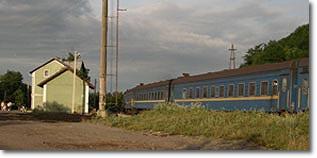 |
|
|
Arriving in Tovste shortly after sunrise
can only be described as enchanting. But unless you happen
to have a welcoming party, hauling one's bags a few hundred
metres to the station over rough track is much less agreeable! |
As mentioned above, one can also travel by overnight train
from Kyiv to Chernivtsi, a journey of about 15 hours or so,
departing early evening (1830) and reaching Chernivtsi at
0930. [As a matter of fact, this is the very same train that
passes through Ternopil in the early hours of the morning,
and which stops briefly in Tovste at around 0630.] Reservations
for this train are hard to come by on weekends, as the sleeping
compartments are heavily booked in advance.
Trains depart from from a recently modernised station in
central Kyiv. To get there from Boryspil Airport, take a "marshrutka"
(minibus) that departs regularly from in front of the terminal
building as soon as there are enough passengers on board.
The journey costs 25 Hryvnia and takes around 45 minutes (more
or less, depending on traffic).
This busy train station is rather large;
and although there are lots of places to sit in the free
public area, the seats tend to be occupied according to
the rules of "musical chairs".
For a more tranquil environment, one can relax instead
in a cavernous waiting lounge nearby for a fee of about
15 Hryvnia. |
|
|
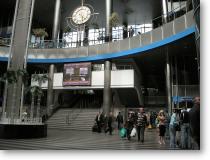 |
Normally one shares a train compartment with other people,
especially since the Kyiv-Chernivtsi route is heavily frequented.
You might use the opportunity to strike up an acquaintance
or simply travel undisturbed, minding your own business. Apart
from the occasional case of overly exuberant travelling campanions,
well-supplied with beer, I have never had a bad experience
traveling with other passengers, taking normal precautions
with valuables etc. Once or twice in the past, I opted to
pay for the whole compartment when I was traveling with family
or when I wanted to be able to spread out papers to work;
but this "extravagance" might not be so easy to
arrange these days if the trains are travelling at capacity.
Travel between Chernivtsi and Tovste 
It is assumed that most visitors to Tovste will want to use
Chernivtsi – 75 km to the south – as a base, since
there is only limited accommodation available in town and
not much on offer in nearby Zalishchyky either (although the
situation there has improved since mid-2006).
If you have not arranged a private car and driver, there
are a couple of options for getting to Tovste from Chernivtsi.
Some 'slow trains' do pass through Tovste on their way north,
but their departure times are generally not convenient for
day trips and they are, by definition, very slow – stopping
at every village along the way.
The quickest way to reach Tovste is by taxi, but not just
any taxi. There are two or three companies that operate fleets
of taxis equipped with standardised meters, which (in my experience)
are transparent and not subject to abuse. They can usually
be identified by the large telephone numbers inscribed on
the sides of the vehicles. The cost of the 75 km one-way journey
from Chernivtsi to Tovste will set you back about 165-190
Hryvnia, depending on where you leave from. By western European
standards, and with current exchange rates of around 12 Hryvnia
to the Euro, this is extremely reasonable.
Note, however, that many cars that "look" like
legitimate taxis – with a light on the roof and perhaps
even with numbers on the side – might not have a meter.
Avoid these unless you are really in a pinch, because there
are unscrupulous drivers who will try to charge whatever they
think you are able to pay. In the late 1990s/early 2000s,
the going rate for a negotiated taxi fare used to be 1 Hryvnia
per km, which worked out to about 75 Hryvnia for the journey
from Chernivtsi to Tovste. Nowadays unregulated taxi drivers
in substandard vehicles demand 3-4 times that much –
well above the increase that could be justified by higher
petrol prices. Stick with meter taxis for short and long journeys,
without exception, if at all possible!
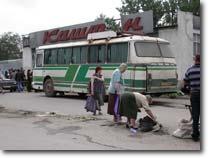 |
|
Another even more economical – though
less comfortable and rather less convenient – option
is to travel to Tovste by public bus. The depot is located
about 10-15 minutes walk from the Cheremosh Hotel down
the road leading east (to the right as you exit the hotel).
|
Buses heading in the direction 'Rivne', 'Ternopil' and 'Dubno'
etc. leave at irregular times during the day. It is several
years since I last used this service, but I recall that the
first bus in the morning departs (theoretically) at about 0650,
but it usually left at least 5-10 minutes late.
| The fare is cheap – only about 15
Hryvnia (less than 3 USD) one way to/from Tovste –
but you get what you pay for. All of the buses are old
and are sometimes prone to breakdowns. The smaller ones
can get extremely crowded, with passengers picked up along
the way having to stand in the aisle for most of the journey.
|
|
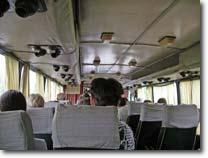 |
There is a wonderful bilingual website (Ukrainian-English!)
that gives schedules for bus services within Ukraine, including
departures
from Chernivtsi and Tovste. It is extremely useful as
a planning tool, especially to show when the first and last
buses of the day operate. From what I can see, the schedule
appears to be accurate though it seems not to cover all of
the buses heading south from Tovste, nor does it show independent
local services (say, from Zalishchyky to Tovste).
Traveling from Chernivtsi on a good day, after a short stop
in Zalishchyky to allow for a cigarette break or for passengers
to use the unspeakably abominable toilet facilities at the
bus depot (you have been forewarned!), you can make it to
Tovste in about 2 hours. Otherwise, if the bus stops for many
passengers along the way, it can take as long as 2 ½
hours. You can ask to be let off in Tovste just about anywhere,
but there is a scheduled stop at the 'depot' more or less
opposite the Greek Catholic church.
Returning to Chernivtsi in the evening can be problematic.
It used to be difficult to find out the schedule for the last
bus and to predict when it would actually arrive. To be on
the safe side, one should stand on the main road leading to
Zalishchyky between 1700 and 1800, and hope for the best.
There is now a schedule on the wall of the bus depot in central
Tovste which seems fairly accurate for forecasting local bus
arrivals and departures, as long as you can read Cyrillic.
Alternatively, there are also 'free-lance' mini-buses that
travel the main north-south highway at random times. These
can be hailed from in front of the supermarket opposite the
bus depot. It costs only about 5 Hryvnia for a shared journey
to Zalishchyky, versus about 50 Hryvnia (or more) by private
taxi. There are no meter taxis in Tovste. If you need to get
back to Chernivtsi in a hurry, there are individuals in town
who may be prepared to drive there for 250 Hryvnia or so,
but identifying the reasonable ones is best done through 'word
of mouth'.
Finally, if you need to return to Lviv to catch a flight –
which typically depart Lviv from early to mid-afternoon –
some ingenuity is required. Trains from Tovste to Lviv are
few and far between, and they tend to leave at inconvenient
times of the day. Buses make the 5-6 hour journey to Lviv
twice a day – early in the morning and in the middle
of the afternoon – but they don't reach Lviv in time
to make the earliest flights. Excluding the option of hiring
a private taxi, which can make it to Lviv airport in about
4 1/2 hours, a good compromise is to take a taxi to Ternopil
(which can be reached in 1 1/2 hours from Tovste) and then
catch an inexpensive train from there the rest of the way
to Lviv. They follow a reliable schedule throughout the day.
When you reach Lviv train station, a 40 Hryvnia taxi ride
will have you at the airport in 15-20 minutes.
Car rental 
It is not so many years ago that hiring a self-drive
rental car in western Ukraine was unusual, if not impossible.
But today, several of the major international rental chains
have branches at the airport in Lviv which offer this service.
The prices are quoted in Euros and, in my estimation, are
fairly expensive.
However, in 2009, I discovered a 'local' alternative that
provided exactly what I required at a very reasonable price.
AUTO-Drive,
which appears to have its headquarters in Lviv and branches
in about a dozen cities throughout Ukraine (including Chernivtsi)
offers a fairly wide range of western and Russian vehicles.
With help from an English-speaking staff member in Lviv, I
was able to organise a two-day van rental from the Chernivtsi
branch for Euros 15 per day, including insurance, with unlimited
mileage. The vehicle was fine and the pre- and post-rental
service was very professional. I would not hesitate to use
their services again in future. This is a viable option for
anyone who feels confident enough to drive by themselves and
alert enough to avoid police speed traps stationed along the
major thoroughfares.
For any of these car rental companies, it is advisable to
reserve well in advance in the months of summer and autumn,
since the supply of vehicles seems not to be sufficient to
meet the demand during these peak periods.
Accommodation 
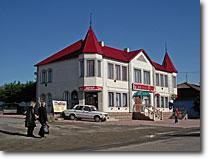 |
|
Until fairly recently there was no accommodation
whatsoever in Tovste, however this changed since the opening,
around 2004, of a motel cum guesthouse, which began to
advertise its services in 2005. The "Dvir Guesthouse"
is located on the way into town, on the left hand side
of the road as one approaches from Zalishchyky. The following
review was written in 2007 and prices may have increased
since then. |
From appearances, it has all of the amenities of a proper
guesthouse, with at least three or four rooms upstairs and
a restaurant on the ground floor. The guest rooms, costing
in the order of 100-200 Hryvnia per night irrespective of
the length of stay (2007 prices) are fairly new and are very
spacious, with en suite bathroom, including shower. There
is even a sauna and Turkish bath on site, which the locals
seem to use. Noise from the main street and adjacent pub,
which is occasionally used for all-night wedding celebrations,
may be a nuisance for light sleepers; and (in 2007) there
were some "issues" related to the water supply and
lax operating procedures.
Notwithstanding these inconveniences,
the Dvir Guesthouse remains the only option readily available
in Tovste, and it avoids the long journey to/from Chernivtsi.
Also, the food in the restaurant, which is open until at least
2200 in the evening, is pretty respectable and good value
for money. As a bonus, much of the menu has been translated
into English, and makes for an amusing read while waiting
for the food to be served.
In 2005, I discovered a couple of other alternative accommodations
options in nearby Chortkiv (Tchertkov), about 20 km to the
north: Hotel Tanya (03552 22755); Hotel Avianosez (03552 21830);
and Hotel Hetman (03553 31284). I know nothing about the first
two, but I did visit the Hotel Hetman, which has clean rooms,
with shower/toilet for 80 Hryvnia per night. It is situated
only about a 5-10 minute walk from where the bus stops on
its way to Tovste. There may well be other alternatives of
which I am not aware.
Zalishchyky, 25 km to the south of Tovste, was a thriving
resort town in the 1930s, but until recently it had no accommodation
to speak of. This situation changed for the better in mid-2006,
when the renovation of the "Old Zalishchyky" hotel
was finally completed. It offers rooms of various sizes ranging
in price from 60-80-120 Hryvnia per night (2007 prices). All
of the bedrooms have been freshly painted and the largest
suites are very spacious. The mid-size room is more than adequate
for two people. All of the en suite bathrooms are small and
very basic. One side of the hotel faces a park and nearby
street, while the other looks onto a courtyard and restaurant
(both potential sources of noise). In any case, the "Old
Zalishchyky" hotel offers visitors a cheap alternative
to staying in Chernivtsi, making Tovste and the surrounding
attractions much more accessible.
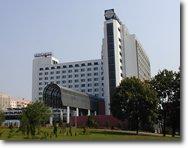 |
|
In Chernivtsi, which is worth visiting in
its own right for at least a couple of days, there are
several accommodation options available: three or four
large hotels catering to outside visitors, as well as
private accommodation in furnished apartments. The Cheremosh
Hotel, situated on the outskirts of town, is well equipped
to handle large tour groups and individual guests. |
Facilities include a number of restaurants, a discotech,
currency exchange office, internet facility, in-house translation
/ interpretation service, multi-lingual tour guides etc. The
room prices are variable – with a very basic double
room costing in the order of USD 45 per night, excluding breakfast,
and more recently renovated rooms costing closer to USD 75
per night. The rooms are by no means luxurious and they are
definitely showing signs of their age, but they have all the
basic amenities: hot/cold water, television, telephone, and
modern refrigerator. For such a modest room rate, one could
hardly expect much more.
| Depending on ones' tastes, the Cheremosh
might not be convenient for those who would prefer to
stay in the centre of town. On the other hand, it is handy
to shops and a market nearby, and to the bus terminal
down the road, and it is easily reached by taxi and public
transport. Also, being on the outskirts of town there
is plenty of greenery nearby. |
|
 |
| |
|
|
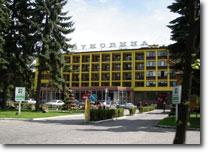 |
|
A comparable alternative to the Cheremosh
is the Bukovina Hotel, located on a main road a little
closer to town. Some parts of the hotel were modernised
some years ago. While I have seen the rooms – which
look okay in the new wing – I have never stayed
at the Bukovina Hotel and therefore cannot comment on
the services. |
At least the hotel management has made a sustained commitment
to maintaining the appearance of the outside of the hotel
and the grounds. The colourful flowers on the balconies always
seem to be in full bloom.
Unfortunately, if you are expecting or looking to find a
higher standard of accommodation in Chernivtsi, it is simply
not available from my experience, except perhaps in more expensive,
privately furnished flats.
Miscellaneous practical advice 
Visas
Citizens of most countries used to have to apply
for a visa to enter Ukraine, before travelling. This entailed
paying upwards of USD 100 for the privilege of sitting for
long periods in the anteroom of an embassy or consular office,
and waiting for officials to deign to serve prospective visitors
to their land. Fortunately, in 2005, visa requirements were
waived completely or relaxed for nationals of countries of
Europe and North America, among others. This eminently sensible
decision on the part of the government should help to attract
more visitors to Ukraine, who might otherwise be deterred
by bureaucratic red tape.
Language
From my experience, is still fairly uncommon
to find people in western Ukraine who speak English.
A good phrase book comes in handy and should be adequate
for most day-to-day situations. There are some exceptions,
however, among Ukrainians who have lived and worked
abroad elsewhere in Europe for a number of years. In
such case, one may be pleasantly surprised to discover
that knowledge of German or Italian holds the key to
being able to communicate relatively easily, even in
towns.
Menus in restaurants tend to be written only in Ukrainian,
so ordering food can be challenging wherever you are.
|
|
 |
Currency exchange
Changing money in Ukraine, even in small towns, is transparent
and very easy thanks to the large number of exchange outlets.
Banks and small money changers use billboards to advertise the
exchange rates for dollars and euros, which may fluctuate from
day to day. What you see is what you get – there are no
hidden commission fees.
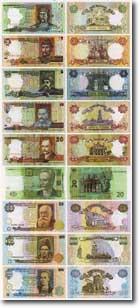 |
|
It is my impression that in recent years,
the Hryvnia has been allowed to float more freely against
the US dollar and euro. Over the past year in particular,
the currency has depreciated markedly against the dollar
and euro. Whereas one used to pay 5 and 8 Hryvnia, respectively,
for one dollar and one euro, the exchange rate in October
2009 was closer to 8:1 and 12:1. Prices for some commodities
– particularly imported goods – have increased
accordingly. While local people are undoubtedly experiencing
hardship as a consequence, the favourable exchange rate
makes Ukraine a bargain for foreigners.
Generally
speaking, there are only small variations in rates from
one exchange outlet to another on a given day, except
perhaps at airports and train stations, which do not
offer as good a rate. This is especially true of the
exchange offices at Kyiv Boryspil Airport: do not think
of exchanging money there unless you are really desperate. |
The solitary bank in Tovste – PrivatBank, on the main
street in the centre of town – is open from Monday to
Friday (1000 - 1700) and on Saturday until 1500. Be prepared
for longer queues on Friday (market day) and Monday mornings.
Also, although the largest bill in circulation in Ukraine
is 200 Hryvnia (around USD 12), the bank sometimes runs short
– leaving you stuck with a fistful of 20's and 10's.
Otherwise, the PrivatBank is a very convenient place to change
money and top up a pre-paid mobile phone account.
Telephone
If you own a mobile phone that works in Europe and are going
to be spending more than a week or so in Ukraine, it is definitely
worth investing in a SIM card (for less than USD 15-20 if
I remember correctly) and then buying top-up cards at ubiquitous
kiosks for 25-50-100 Hryvnias (USD 3-6-12) each. As an alternative
to buying cards, which are not always available in large denominations,
one can also purchase extra phone time (eg. 100 Hryvnia) through
PrivatBank.
Kyivstar and UMC are the two main competing mobile services.
The per minute calling charge isn't cheap, but the convenience
of making/taking a call from just about anywhere in the domestic
network makes it worthwhile. From my experience, Kyivstar's
SMS capability is also very handy. I recently discovered,
to my great surprise, that the Kyivstar SIM card even works
for SMS while travelling in some countries outside of Ukraine
(eg. in Germany and Italy).
If you don't have a mobile phone, I think it is still possible
to purchase phone cards in various denominations from the
official telecom authorities, and these can be used for making
inexpensive calls from public pay phones.
To dial abroad, one must use the prefix '810', followed by
the country code, area code and number. Phoning from a fixed
line within Ukraine can be a little tricky. If you are dialing
from one locale (region) to another, you must first dial '8',
then the area code of the other location, followed by the
number. For example, to call Tovste from Chernivtsi, one would
dial: '8' then '03554' then the (five digit) local number.
However if you are calling a number within the same area,
it suffices to dial only the number (without '8' or area code),
otherwise you will not be connected.
Important update: The Kyivstar
website has announced that as of 14 October 2009, Kyivstar
would adopt a widely accepted international standard for dialing
outgoing calls, whereby international calls are to be prefixed
by '00' instead of '810'; intercity calls will no longer require
the '8' prefix; and calls made with the Kyiv region (formerly
prefixed by 8 044) will henceforth require the prefix 0 45.
I am not sure whether UMC has also adopted this new convention,
but it seems likely.
Day-to-day
Toilet facilities are an issue in towns and villages of western
Ukraine, even ones of a fairly large size. Such facilities
are generally not available and any respectable ones attached
to offices or public buildings tend to be hidden away, out
of sight, and/or under lock and key. Indoor plumbing in houses
is still a rarity in towns the size of Tovste; more often
than not the only toilet available will be a wooden outhouse,
located behind the private dwelling you might be visiting.
If you are thinking of using a public lavatory before heading
off from Chernivtsi, think again. The almost 'surreal' public
toilet in the basement of Chernivtsi railway station –
possibly constructed in the early 1900s and, by appearances,
not upgraded since then – ranks as one of the most abominable
on the planet.
An exception to this rule of thumb seems to be the many petrol
stations that have sprouted up all along the highway leading
from Chernivtsi to Tovste. It may be advisable to stop en
route and take advantage of the rare chance of a clean toilet
that these service stations offer. No other solution to this
problem comes to mind, apart from advising one to drink sparingly
before and during the journey! 
|

